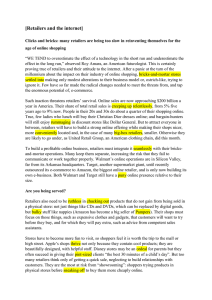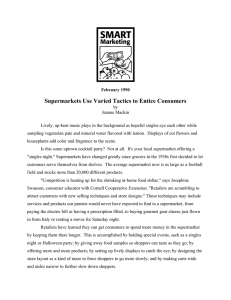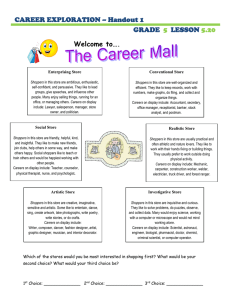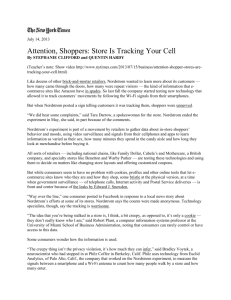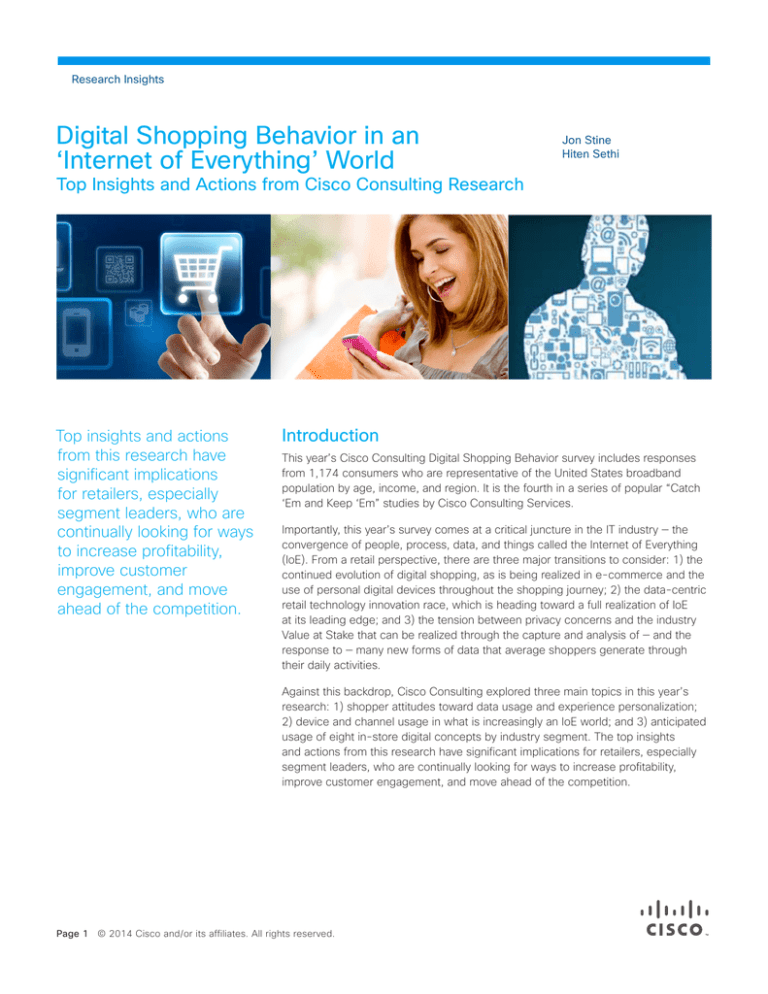
Research Insights
Digital Shopping Behavior in an
‘Internet of Everything’ World
Jon Stine
Hiten Sethi
Top Insights and Actions from Cisco Consulting Research
Top insights and actions
from this research have
significant implications
for retailers, especially
segment leaders, who are
continually looking for ways
to increase profitability,
improve customer
engagement, and move
ahead of the competition.
Introduction
This year’s Cisco Consulting Digital Shopping Behavior survey includes responses
from 1,174 consumers who are representative of the United States broadband
population by age, income, and region. It is the fourth in a series of popular “Catch
‘Em and Keep ‘Em” studies by Cisco Consulting Services.
Importantly, this year’s survey comes at a critical juncture in the IT industry — the
convergence of people, process, data, and things called the Internet of Everything
(IoE). From a retail perspective, there are three major transitions to consider: 1) the
continued evolution of digital shopping, as is being realized in e-commerce and the
use of personal digital devices throughout the shopping journey; 2) the data-centric
retail technology innovation race, which is heading toward a full realization of IoE
at its leading edge; and 3) the tension between privacy concerns and the industry
Value at Stake that can be realized through the capture and analysis of — and the
response to — many new forms of data that average shoppers generate through
their daily activities.
Against this backdrop, Cisco Consulting explored three main topics in this year’s
research: 1) shopper attitudes toward data usage and experience personalization;
2) device and channel usage in what is increasingly an IoE world; and 3) anticipated
usage of eight in-store digital concepts by industry segment. The top insights
and actions from this research have significant implications for retailers, especially
segment leaders, who are continually looking for ways to increase profitability,
improve customer engagement, and move ahead of the competition.
Page 1 © 2014 Cisco and/or its affiliates. All rights reserved.
Research Insights
Insight No. 1:
Eighty percent of shoppers are now “digital” — and a growing
number are “Über Digital”
Once again, the survey confirmed what is increasingly obvious to most retailers in
the United States — it’s now a digital world. Eighty percent of shoppers fall into what
we term the Digital Mass category, in which shoppers regularly buy (from browsing
to purchasing) through digital means. This category, with a median age of 40 to 44,
comprises primarily PC-based shoppers, although they will also use other devices
(including tablets and smartphones) within their shopping journeys.
The other key segment — and perhaps most important for the purposes of future
planning — is what we term Über Digitals. This segment, with a median age between
30 and 34, represents 18 percent of the population (up from 11 percent last year).
These shoppers often use smartphones and tablets when shopping in the store.
This group also accesses other digital devices, such as tablets, PCs, and touchscreen devices provided by retailers during the shopping journey.
Shopper suspicion of
retailers’ use of data is a
major barrier to realizing
value. Simply stated, this
issue is one of trust and
transparency.
Insight No. 2:
Retailers must overcome shopper distrust to maximize value
from IoE and Big Data/analytics
When asked, “How much would you trust these companies/institutions to protect
your personal data and use it to provide something that you value?” respondents
listed retailers (31 percent) fifth out of six types of well-known enterprises that work
with personal data. This fell below hospitals and healthcare, financial institutions,
credit card companies, and even government agencies, the latter of which came
in at 37 percent. Retailers ranked only above Internet companies (18 percent).
Other recent studies have also found low levels of trust with retailers in addition to a
decline in trust levels over the past two years.*
These findings point to a significant issue for retailers. Industry experts suggest that
the use of Big Data, advanced analytics, and IoE-driven automation and process
improvement could have added an additional $99 billion in value to the United
States retail industry in 2013. However, shopper suspicion of retailers’ use of data
is a major barrier to realizing that value. Simply stated, this issue is one of trust and
transparency.
The research showed that a clear majority of shoppers are willing to share only what
we term “transactional” information (i.e., data created by a purchase in the store),
even if data sharing can create a more personalized shopping experience. More
than half of the Digital Mass and Über Digital customers said they would be willing
to share their past purchase histories and basic information, such as name, gender,
and age. Nearly half of both segments would be willing to share data on their likes
and dislikes on an opt-in-only basis. The research also uncovered what we term a
“trust cliff” — where the willingness to share information beyond these areas drops to
30 percent or less. In fact, when it comes to personal information that is considered
to be acceptable for retailers to use, a significant percentage of Über Digitals (25
percent) and Digital Mass (13 percent) selected “none of the above.”
* Data Agency survey of more than 1,000 consumers in the United Kingdom showed that “high-street” chains have
seen a decrease of 11 percent in trust since 2011. Source: Marketing Week, 2013.
Page 2 © 2014 Cisco and/or its affiliates. All rights reserved.
Research Insights
Insight No. 3:
Consumers start the shopping process at home, and prefer
to receive offers via email rather than in-store
It was no surprise that shoppers by a large margin were open to receiving
personalized offers from retailers. Interestingly, most shoppers asked to receive
these personalized offers via email at home rather than while entering or moving
about in stores. Seventy-six percent of Digital Mass and 69 percent of Über Digital
shoppers want to receive email at home. For the Digital Mass segment, only 15
percent want offers upon entering a store, and 6 percent want offers while shopping
in the store. For the Über Digital segment, only 26 percent want offers upon
entering a store, and 13 percent want offers while shopping in the store.
The findings suggest that consumers — even Über Digitals — start the shopping
process (which includes consideration, research, and preparation) while they are in
their home environment. The vision of in-store offers may simply not be in sync with
the reality of shopper decision making and in-store behavior.
Even Über Digitals start the
shopping process (which
includes consideration,
research, and preparation)
while they are in their home
environment.
Insight No. 4:
Customers are more likely to provide personal information
when retailers offer a discount on the next purchase
Despite shoppers’ concerns about privacy, retailers can utilize two techniques for
gaining more customer information that can be used to personalize offers where,
when, and how shoppers want. Digital Mass and Über Digital shoppers were nearly
equal in saying they would provide more personal information if a retailer guaranteed
either a percentage discount (52 percent, Digital Mass; 51 percent, Über Digital)
or dollar savings (52 percent, Digital Mass; 53 percent, Über Digital) on their next
purchase.
A similar “value cliff” appeared in the research, as all other responses were much
less popular. Answers including ability to use loyalty points at more than one retailer,
admission into a club that receives priority service, and admission into a club that
receives priority offers all ranked below 27 percent. Interestingly, 31 percent of
Digital Mass and 39 percent of Über Digital shoppers indicated they would provide
more personal information to a retailer that had world-class privacy policies. This
answer fell almost directly between the other two groups of responses.
Insight No. 5:
Digital shopping is now the norm
The research found that digital forms of shopping are now the norm. Combined, instore touch-screens and mobile devices make up 50 percent of shopping methods
for Mass Digital shoppers. As expected, digital shopping for Über Digital shoppers
is greater than 90 percent across all digital channels, including smartphones in
stores (100 percent), PCs at home (99 percent), tablets at home (95 percent),
smartphones at home (91 percent), and smartphones on the go (90 percent).
Page 3 © 2014 Cisco and/or its affiliates. All rights reserved.
Research Insights
The only category where Über Digital shoppers fell below the 90 percent mark
was touch-screens in stores, at 82 percent. This is most likely because they prefer
to use their own smartphones in stores rather than the digital devices offered by
retailers. In fact, only 18 percent of Über Digital shoppers said they preferred to use
store devices.
Insight No. 6:
Omnichannel shopping growth is flat overall — but continues
to rise among Über Digitals
With all of the attention paid to omnichannel retailing, it was somewhat surprising
to find that the prevalence of cross-channel shopping appears to have reached a
plateau. This year’s overall results were very similar to last year’s, given the margin
of sampling error. However, we did see a different picture emerge from the Über
Digital results. This group of shoppers is still pushing the envelope of cross-channel
shopping. For example, in 2012, 60 percent of Über Digital shoppers searched for
items online and bought them in a store. In 2013, that percentage increased to 72
percent. Searching for a product in the store and buying online also increased, from
39 percent in 2012 to 59 percent in 2013 — an indication that showrooming may not
be completely dead.
It is clear that online
reviews on retailers’
websites continue to
increase in importance
as a buying influencer.
In 2010, 44 percent of
respondents indicated that
online reviews on retailers’
websites were an important
source used in making
buying decisions. This result
increased to 52 percent
in 2012 and 58 percent in
2013.
The other significant increases for Über Shoppers were in the area of shopping
on mobile devices. In 2012, 33 percent of Über Digital shoppers searched for a
product on their mobile device and purchased it in a store. In 2013, this number
increased to 70 percent. Additionally, 32 percent of Über Digital shoppers started
their shopping journey on a mobile device and finished it on a PC in 2012. In 2013,
this number increased to 62 percent.
Insight No. 7:
Online reviews by peers and experts have the greatest
influence on buying behavior
When it comes to understanding the relationship between shopper trust and
influences on buying behaviors, it is important to recognize the subtleties involved.
While different types of relationships engender various levels of trust (as discussed
above), expertise on a given subject (i.e., which product is a better value) also
influence Mass Digital and Über Digital shoppers when they’re making purchase
decisions.
It is clear that online reviews on retailers’ websites continue to increase in
importance as a buying influencer. In 2010, 44 percent of respondents indicated
that online reviews on retailers’ websites were an important source used in making
buying decisions. This result increased to 52 percent in 2012 and 58 percent in
2013. When studied in the context of other influencers, additional important insights
emerge.
The top two buying influencers for both Digital Mass and Über Digital shoppers are
online peer reviews/ratings and online reviews from experts. Interestingly, advice
from friends and family ranked third (about 20 percentage points from the top
Page 4 © 2014 Cisco and/or its affiliates. All rights reserved.
Research Insights
answer). Store associates ranked last, at 14 percent. Given the investment in store
labor across the industry, we see the latter as a major issue that can be explained by
both perceptions of expertise and trust. In a world of online research, shoppers are
likely to walk into a store with equal or better knowledge about a specific product
than an associate covering one or more departments. And in a world of declining
brand trust, shoppers may be quick to sense the self-interest behind advice from
someone wearing the retailer’s logo.
Insight No. 8:
Shopper expectations continue to ramp, with “better values”
and “price visibility” key factors
When asked, “How have your expectations for shopping changed over the past two
years?” the top three answers from Digital Mass shoppers were better values, at 71
percent; price visibility, at 61 percent; and wider product range, at 58 percent. The
top three responses for Über Digital shoppers were better values, at 79 percent;
information access, at 75 percent; and price visibility, at 72 percent. These findings
indicate that shopper expectations continue to increase overall.
At 14 percent, store
associates ranked last as
a buying influencer for
both Digital Mass and Über
Digital shoppers. Given the
investment in store labor
across the industry, we
see the latter as a major
issue that can be explained
by both perceptions of
expertise and trust.
Insight No. 9:
“Best Personal Price” smartphone application was the top
pick among eight in-store concepts tested by Cisco
Cisco Consulting tested eight in-store concepts designed to catch and keep Digital
Mass and Über Digital shoppers. Several of these concepts are on the drawing
boards of leading retailers across multiple industry segments. These concepts can
be implemented as designed or for use as “thought starters” to provide fresh ideas
for new, innovative in-store solutions.
1) Best Personal Price — An opt-in smartphone application that combines all of a
customer’s relevant offers, coupons, and loyalty points, and then calculates the best
personal price for an item or service. At 63 percent of all respondents who indicated
they would use the concept frequently or always, Best Personal Price was the most
popular concept by a wide margin (more than 20 percent). Among Über Digitals, 82
percent selected this concept. The top segment was consumer electronics, at 71
percent.
2) Mobile Concierge — An opt-in smartphone application that greets customers as
they enter the store, guides them to the items they want, and provides shoppers
with interest- and location-based information and offers. With 42 percent of all
respondents saying they would use Mobile Concierge frequently or always, it was
the second-most-popular concept. Among Über Digitals, 66 percent selected this
concept. The top segment was consumer electronics, at 47 percent.
3) Beat the Buzzer — A gamification solution for use on PCs, laptops, tablets,
and smartphones at home or in the store that offers a special promotion for a
limited time. Shoppers who participate can receive awards. At 35 percent of all
respondents who indicated they would use the concept frequently or always, Beat
the Buzzer was the third-most-popular concept. Among Über Digitals, 56 percent
selected this concept. The top segment was grocery, at 37 percent.
Page 5 © 2014 Cisco and/or its affiliates. All rights reserved.
Research Insights
Cisco Consulting tested
eight in-store concepts
designed to catch and
keep Digital Mass and Über
Digital shoppers. Several
of these concepts are on
the drawing boards of
leading retailers across
multiple industry segments.
These concepts can be
implemented as designed
or for use as “thought
starters” to provide fresh
ideas for new, innovative instore solutions.
4) Connect the Dots — A gamification solution for in-store use on tablets and
smartphones that collects tokens or QR codes throughout the store. Shoppers
who participate can win awards. Just one percentage point below Beat the Buzzer,
Connect the Dots was the fourth-most-popular concept, at 34 percent. Among
Über Digitals, 55 percent selected this concept. The top segment was consumer
electronics, at 37 percent.
5) Remote Consultation — Appears on fixed and mobile screens. With one click and
no appointment, shoppers can talk to a brand specialist to get questions answered
and learn about products. At 31 percent of all respondents who indicated they
would use the concept frequently or always, Remote Consultation was the fifthmost-popular concept. Among Über Digitals, 50 percent selected this concept.
The top segment was home improvement, at 39 percent.
6) Endless Aisle — An online and in-store solution on fixed and mobile screens that
shows shoppers a brand’s entire inventory on desired SKUs. The Endless Aisle also
shows nearby stores and websites that carry the desired products. Endless Aisle
was tied with Solution Builder, at 29 percent, for the sixth- and seventh-mostpopular concepts. Among Über Digitals, 50 percent selected this concept. The top
segment was apparel, at 32 percent.
7) Solution Builder — An online and in-store solution on fixed or mobile screens that
suggests projects, builds shopping lists, and creates recipes based on products of
interest. Solution Builder was tied with Endless Aisle, at 29 percent, for the sixthand seventh-most-popular concepts. Among Über Digitals, 50 percent selected this
concept. The top segment was home improvement, at 33 percent.
8) Social Shopping — A smartphone app that integrates popular social sites such as
Facebook, Pinterest, and Twitter, allowing select family, friends, and acquaintances
to provide feedback or advice on purchases. At 21 percent of all respondents who
indicated they would use the concept frequently or always, Social Shopping was
the least-popular concept. Among Über Digital shoppers, 43 percent selected this
concept. The top segment was home improvement, at 24 percent.
Page 6 © 2014 Cisco and/or its affiliates. All rights reserved.
Research Insights
For retailers to realize the
promise of personalization
from Big Data, they must
establish trust with their
customers that information
will be 1) captured and
used in permissible ways;
2) will be used nonintrusively; 3) will be secure
and safe; and, ultimately, 4)
will create tangible value for
shoppers.
Recommended Actions for Retailers
Action No. 1:
Take steps necessary to earn shoppers’ trust regarding their
personal data
For retailers to realize the promise of personalization from Big Data, they must
establish trust with their customers that information will be 1) captured and used
in permissible ways; 2) will be used non-intrusively; 3) will be secure and safe;
and, ultimately, 4) will create tangible value for shoppers. The lack of trust found
in the survey results stands to prevent the U.S. retail industry from realizing the full
economic value of IoE (estimated at an incremental $99 billion in 2013). Data is the
fuel that will drive retail innovation and value creation in the years ahead. However,
without greater attention to the issue of earning shopper trust, the promise of
personalization may be an empty one.
Action No. 2:
Provide the speed, convenience, information access, and
product assortment that Über Digital shoppers demand
Last year, Über Digital shoppers accounted for roughly one in 10 customers. This
year, one in five shoppers is Über Digital. And although Über Digitals are younger
on average, more than one-quarter of the survey’s Über Digital respondents are 40
years of age or older. Über Digital shoppers represent a step-change in shopping
behavior. Each store visit is accompanied by a smartphone, and nearly every
shopping journey is digitally influenced.
For retailers, the message is clear: in all aspects of the retail experience, Über
Digital shoppers expect the speed, convenience, information access, and available
assortment found on the Internet. The net is their norm.
Action No. 3:
Deliver an Internet-like experience in-store
The digitally equipped, digitally expectant shoppers of tomorrow (let alone today) will
increasingly prefer a store that provides an Internet-like experience. For competitive
retailers, these expectations demand a network that delivers abundant bandwidth
and low latency, as well as flexible, agile store architectures that enable the rollout of
new functionality to all stores in days (not years).


